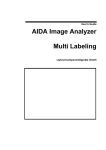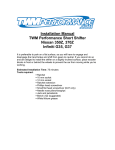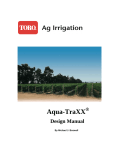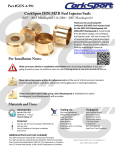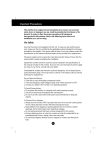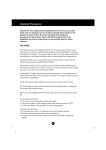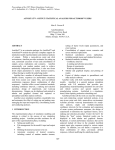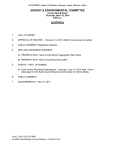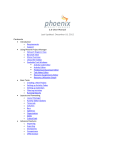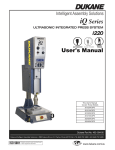Download Irrigation text only - Sustainable Market Farming
Transcript
Irrigation © Pam Dawling 2012 Providing sufficient water can make a lot of difference to the vigor and productivity of crops. In most cases the times to prioritize watering are when the seeds or transplants first go in the ground, and when the plant is producing the part that will be eaten. Overhead rotating sprinklers are cheaper to buy and easier to understand than drip irrigation, and in some circumstances they do a better job, for instance when you need to water in a broadcast cover crop or closely drilled rows. Commercial growers often use some drip irrigation, as it greatly reduces the amount of water used, and waters only the crop, not the weeds between the rows. Overhead Sprinklers We have seven mobile overhead sprinklers in our vegetable plots, and when we need to water we run three at a time, overnight. Having more sprinklers than we are going to use at once means we don’t have to move them (and their hoses) far, usually just up and down in one plot. We water at night as it reduces evaporation losses, and also makes it more convenient for working during daylight hours. We run three at once because this is the highest number we have enough water pressure for, and it keeps the well-pump running full-time at 15 gallons per minute (57 liters/min). If a pump has to cycle on and off while water is running, it will wear out sooner, and pulling and replacing a pump in a deep well is not the easiest job. Running too many sprinklers at once will mean they stop going round at some point, and make an eroded washedout area. I’m an advocate for buying good quality sprinkler heads, to reduce problems. I notice each spring, when I test the sprinklers before setting them out in the fields, that the Rainbirds and Nelson sprinklers start right up, while the economy models have to be coaxed into performing. Sprinkler heads can be attached to tripods made at home from rebar with a bit of welding, or adjustable tripods can be bought. Each of our tripods has a toothbrush attached to it with a length of thin wire. This basic toolkit is often enough for cleaning the filter washer in the inlet, or clearing a dead spider from the jet. If you are going to irrigate at night, you will also need a light – a headlamp with LED bulbs works well as long as the batteries are well charged. (LED flashlights seem to fade fast when batteries are failing.) If we are going to rotate around an area repeatedly (such as our raised beds where we grow a variety of crops very intensively) we use stake flags to mark the sprinkler spots. For our system, watering from 10pm to 7am provides about ¾” (2 cm) of water. Test with a rain gauge or tuna can. That’s 5500 gallons (20819 liters) for 3 sprinklers. By contrast, three drip zones for 2 hours use less than half this amount of water, and water perhaps 3 times the area of crops, because the water is focused on the crop rows, not the whole area. Drip Irrigation Drip irrigation uses plastic tubing with emitters at fixed spacings, and a reduced pressure water supply, to slowly provide water for a row of plants. The water seeps into the soil, so very little is lost to evaporation, even if plants are watered in the middle of the day. If you are new to drip irrigation, consult the catalogs and websites of the suppliers, and try a pilot scheme for one season. Our pilot scheme was our 3 long rows of paste tomatoes and 2 of sweet peppers, partly because we wanted to reduce foliar diseases, which are often spread by water droplets. These crops have long seasons, so once the system was in place in May, we could leave it until November. Our pilot scheme convinced us to use more drip irrigation. Now we have about 10 or 12 sub-systems in place each year. A sub-system is a set of runs of drip-tape operating from a single faucet, along with its timer, pressure reducer and 200 mesh screen filter, and the header pipe the drip-tape runs are attached to. The first item off the hydrant, the timer, has its own conical filter washer. Once a month we clean both the filter washer and the screen filter with a toothbrush. The screen filter can also be backwashed, for a quick clean. If you are using surface water (from a river or pond) you will need a sand filter first, to remove coarse particles. Each type of drip tape has a maximum functional row length, depending on the spacing of the emitters and whether it is made for low or high flow rates. We use low-flow tape with 8” (20 cm) spaced emitters, which (according to the suppliers) has a maximum single length of 460’ (140 m) on flat ground, 700’ (213 m) downhill, if uninterrupted by fittings that reduce the flow. Using the barbed “LSB” connector it’s 380’ (116 m). Design your sub-systems so the runlengths don’t exceed the maximum for the tape you’re using. To calculate the total length of drip-tape you can run at one time, you need to know the rate at which your tape emits water, and the output per minute of your water supply. Our tape, at 8 psi (0.55 bar), can provide 20.4 gallons per hour/100’, or 0.34 gallons per minute/100’ (254 liters per hour/100 m, 4.23 liters per minute/100 m). Our calculation: We measured 7.5 gpm (28.4 lpm) at the hydrant (= 450 gph, 1704 lph), by running the water into a bucket while we timed it. Calculating at 80% efficiency to allow for friction losses, we can get 360 gph (1363 lph). Divide by the 20.4 gph/100’ the tape can provide = 1764’. (1363 lph divided by 254 lph/100 m = 537 m). This is the maximum total length of tape in one zone on our system (running at one time from one faucet). In terms of well-pump life, it is better to run a bit more than calculations suggest, rather than less. We run this 1764’ (537 m) as 10 lengths of 180’ (54.8 m) - the width of our West garden - or 7 lengths of 265’ (80.7 m) - our East Garden. In practice we still get acceptable results with 11 x 180’ (54.8 m), or 1980’ (537 m), 12% more than calculations suggest. If the drip tape is old, full of repairs or leaky, you won’t be able to run so much at once. If there are no other draws on our 15 gpm (56.7 lpm) well at the same time, we could run 2 zones at once. There is an easy-to-use calculator on the Dripworks website. You provide figures for the water available in gph, the total length of feet of driptape you want to run and the type of drip tape you will be using. The calculator tells you how many zones you need to divide the area into, or whether it can all be one zone. When in use, the drip tape will look round and taut. It is also useful to calculate how long to irrigate to achieve 1” (2.5 cm) depth of water. We usually run ours twice a week for 2 hours each time. We test the soil by digging down in between emitters or between rows of tape, depending on the crop. Most of the calculations I’ve seen suggest that every spot of the soil needs to be watered, but with widely spaced crops, I do not think this is the case, so I prefer to dig and look, rather than calculate. The type of soil you have will determine how close together to put the rows of drip tape, and the emitter spacing to choose. Low-flow drip tape enables you to run longer individual lengths. Closer spaced emitters are more important for sandy soils, where the water seeps down rather than sideways, but the maximum tape length and the amount you can run at once will be shorter than with wider spaced emitters. Agricultural Plastics We have been hesitant to embrace the use of agricultural plastics because of decreasing world stocks of oil, increasing air pollution, climate change, and problems of how to dispose of plastics responsibly. But sometimes plastics are so useful they’re irresistible! So our policy is to use plastics if they offer a significant advantage, and then make them last as long as possible, find uses for the scrap plastics where possible, and find somewhere to recycle the final mess. Drip-tape is a good example: drip irrigation reduces water use and decreases foliar diseases compared with overhead irrigation. Because only the rows of crops are watered, and there are no losses to evaporation, it enables larger areas to be irrigated well with a given amount of water, which is increasingly important as droughts become more common. For widely spaced rows, drip-tape offers the advantage of not watering weeds in between the crop rows. We buy the thickest drip-tape, 15mil, so that it will last as long as possible (4 or 5 years?). We try our utmost not to mow or till it! We attach the ends to stake flags with string, so we know where they are. We add a little extra length to each new run of drip-tape, to compensate for future shortening when the tape springs a leak and needs to be spliced. We make a practice of writing the approximate length on each end of each piece of driptape. A China Marker/Grease Pencil in yellow, white or orange works well. This simplifies reuse and minimizes the frustration of setting out a piece too short. We learned the hard way to always keep a big supply of splicing connectors, and several rolls of sticky PVC electrical tape for repairs. We learned to do electrical tape repairs on small holes while the water is running. This causes the electrical tape to conform better to the in-use shape of the drip-tape, and leak less. Wrapping diagonally up and down over the hole a few times will give a good repair. Yellow electrical tape is more visible than black, which can be an advantage. At some point with old drip-tape, the cost of connectors making repairs in a length becomes more expensive than replacing that run and salvaging the connectors. In terms of cash, simple mathematics provides the answer. But many of us just hate throwing plastics away, and so we do less than (or more than?) rational decision-making on this. For most people the throwaway point seems to be around 2 connectors per 100-200’ (30-60 m). We haven’t developed a firm rule for ourselves on this yet. Drip Tape Storage At the end of the season, some growers pull the drip-tape to the side of the field and leave it there. Others ball it up, stuff it into bags and store it that way. We want to get the most use out of ours, minimize the damage from mice and voles (which we have lots of) over the winter, and make it easy to set out the tape again the next year. At a Virginia Association of Biological Farmers field day, we saw a shuttle system with an A-frame shuttle holder, developed by Marlin Burkholder. Marlin’s system of raising beds, laying drip-tape and plastic mulch is tractor-based. I got together later with another grower at the field day, to modify the system for use without tractors. Making Shuttles Our shuttles rotate on lengths of rebar resting on the top of a garden cart. The rebar is held in place on each side of the cart by two large spring clamps from the woodshop (like giant clothes pins). Visegrips would work, if you have enough. Or you could make permanent wood or metal additions to the sides of your cart to hold the rebar. We have 6 carts, and they stray a lot, so we could never be sure of finding the cart with the axle set-up, so it’s easier for us to find 4 spring clamps each time. We use scrap white oak stretcher bars from our hammocks business to make shuttles. The dimensions are 1.25”x0.75” (3x2 cm), but anything similar would work. We have the larger style of garden cart (Carts Vermont and Johnny’s have them). We found that a 28” (70 cm) height of shuttle was the tallest workable. For a smaller cart, make 24” (60 cm) shuttles. Here’s a parts list for one large shuttle: 1.25” (3 cm) x 0.75”(2 cm) lumber: 2 pieces 28” (70 cm) long 2 pieces 13 5/8” (34.5 cm) long 2 pieces 12” (30 cm) long 16 screws approximately 1.5” (3.8 cm) long Drill a hole in the center of each of the 28” (70 cm) lengths through the flat side, wide enough to easily fit your rebar axle. Screw the 12” (30 cm) pieces between the long pieces, about 5” (12.7 cm) in from the ends of the long pieces. Screw the other pieces across the shuttle offset from each other, a little above and below the axle holes. These cross-braces strengthen the shuttles and give a handy place to tuck the starting end of the drip-tape. We found it convenient to cut several boxes full of shuttle parts when the lumber became available, and then make the shuttles later when time allowed. One shuttle this size can hold 400’ (122 m) of tape, maybe more. We generally wrap two lengths at once onto one shuttle. Using Shuttles To wind used drip-tape from the field, first open the ends of the drip-tape and flush water through to clear sediment. If this can be done the day before winding, it makes the job drier and easier. Then line up your cart with a shuttle on the axle between two runs of drip-tape at the top of the field. Disconnect the drip-tape from the supply pipe, and tug at the end of the tape nearest the cart. Sometimes it will just pull through any accumulated crop debris and weeds, sometimes it won’t. If it won’t, walk back down the line tugging the tape and free it from what is snagging it. If you have two people to work on each shuttle, two lines can be wrapped at once. Tuck the starting ends of the drip-tape around the shuttle and under one of the cross-braces. Then steadily turn the shuttle end over end, wrapping the tape around the shuttle. If the field has any slope at all, it will be drier work if you are at the high end of the field and the drip-tape is draining as you wrap it. If you’re rolling two lengths at once, obviously the two people will need to co-operate, and stop if one length gets snagged up. When you get to the final end of the drip-tape, check that the length is marked on the tape, and tuck the loose end under a couple of rounds of wrapped tape. We also write the contents of the shuttle on the side with a permanent marker, eg “ 2 @ 150’ ”. We store our shuttles of drip-tape in a barn, tied by rope through the axle holes, and the rope thrown over a beam, as if storing food safe from bears when backpacking. Another shuttle balances the weight of the first. This keeps the drip-tape fairly inaccessible to mice. To reuse the drip-tape next season, use the cart and the rebar axle again. Unrolling is much quicker than winding up, especially if you have two lengths of drip-tape on one shuttle. Two shuttles can be put on one axle side by side, and two people can walk out with two runs of drip-tape each, one in each hand. Uses for Old Drip Tape There are several ways you can use old drip-tape rather than search for a recycler. The longer pieces can be kept for repairs. Short pieces can be cut to use as end caps, or you can make “dead-ends” to close unneeded connectors in a supply pipe used in previous years. Rather than remove the connectors and use goof plugs to fill the holes, leave the connectors and attach 6” (15 cm) capped off pieces of drip-tape. The pipe will stay in better shape (goof plugs can be hard to remove), and the dead-ends are easy to find the following season when they may be in just the right place for that season’s drip-tape runs. I’ve taken to writing on the supply piping too, with a China Marker, the length, and the distribution of drip-tape connectors. I’ve often wished for quick connectors as are available for hoses, so I could quickly switch different pieces of supply piping. So far they don’t exist (do tell me if you find some!). The main use for old drip-tape is as batten tape for fastening plastic sheeting to wood, for hoophouses and cold frames. It’s more weather-resistant than bicycle inner tubes, and cheaper than the real batten tape sold by greenhouse suppliers. If you don’t need it, maybe another grower does? Try advertising on Freecycle or asking at your local farmers’ get-togethers. Resources Roberts irrigation products Ro-Drip User Manual: www.trickl-eez.com/rodrip.pdf Aquatraxx Drip Irrigation calculator: dripirrigation.org/Calculator/Calculator.html Dripworks calculator: www.dripworksusa.com/ttape-2.php?lnk=left Penn State Drip irrigation for Vegetable Production: agalternatives.aers.psu.edu/Publications/DripIrrigation.pdf





